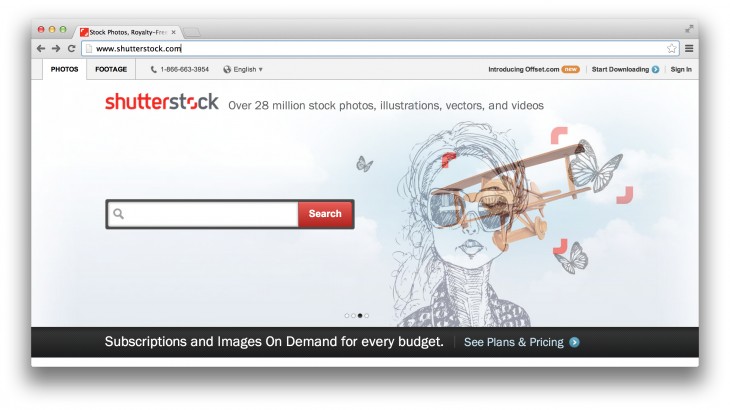
Although it’s still considered a relative newcomer in the photography industry, at ten years old, Shutterstock is part of the old guard of the New York tech scene.
A decade on, the company still has fresh ideas, like the high-end marketplace Offset that it launched last week, and its recently-announced deal with Facebook that will see advertisers able to add stock images to their ads directly from the social network’s interface.
At The Next Web Conference USA in New York City this week, Shutterstock founder and CEO Jon Oringer will be giving a talk called ‘The next generation of the Internet and how data will win’. We caught up with him to hear about how data drives the decisions of a company with no intention of resting on its laurels as it sees its potential market expand.
Data-driven from the off
“When I started Shutterstock, I started with my own images and what I had to do was go from a small collection of images that were not so great to get a library of images good enough for the customers I wanted,” Oringer explains.
“I was getting buyers coming in, brand names that I recognised. They were taking my images but I could tell that they were looking for something more, so when I went to open up the floodgates and allow any photographer to contribute, I needed to do that in a way that meant the contributors knew what to contribute.
“If they were blind to the content that the buyers wanted, the marketplace would have never been successful. So that was the first data challenge that we ran into,” says Oringer. The way Shutterstock solved this problem was to build a system that showed photos being bought in real-time.
“What happened was, they were motivated to go out and create more stuff like what was selling,” he explains. “As they saw each download happen, they would get a feel for what the marketplace wanted at that time.
“And it would constantly change, depending on what holidays were coming up, what the fashion styles were that year, depending on what new cellphone that was out. Every photo that was getting downloaded reflected this stuff – and all of this was data, and without that, the organically-grown marketplace would have never happened. So that was the first realization back in 2003.”
The ‘stock’ market
In the ten years that have followed, Shutterstock has grown to the point where it’s selling three images every second. However, Oringer isn’t worried about demand for stock media having peaked. In fact, he’s upbeat about the growth of the sector as a whole.
“I see more and more consumption and more and more creation, The dynamics that drive our marketplace are going one direction, and that’s up. We’re seeing more and more people using imagery,” he notes.
Part of the increase in consumption is down to the trend for more frequently updated Web content, although Oringer gives Shutterstock’s deal with Facebook as an example of how the company is pushing for growth beyond the typical market of bloggers and online marketers.
In tandem, the rise of high-quality cameras built into smartphones has helped drive an increase in the number of photos submitted to Shutterstock, likewise with HD stock video, thanks to the ability to shoot it being built into many modern digital SLR cameras.
Commoditizing the high end
The launch last week of Offset, Shutterstock’s new outlet for high-end, premium photographs, saw the company aim for growth by again targeting a market that doesn’t usually have access to the convenience of a stock media marketplace.
“We serve a segment of photography that’s high volume, it’s the fastest-growing segment,” Oringer says. “The system that we invented here for crowdsourced photography enables creatives to constantly be able to grab what they need.
“The thing is, once in a while our customers are also looking for something with a higher production value, something that’s really special,” he continues. “Typically they would go to one of the other agencies for that. We found that (these images) were typically rights-managed (and) the process was very complex and cumbersome.
“You would have to detail exactly how you were going to use the image, when you were going to use the image, how long you were going to use the image for, exactly what countries the image would be used in, and you would get quoted a price.
“This is the typical rights-manger format that this type of quality image would be associated with. You’d have to talk to a rep during business hours, it was a very complicated process.”
Offset solves this problem by offering premium images at a single $500 price point, via a simple online interface. While it’s too early to say whether it will be viewed as a success by the respected photographers it’s targeting through the marketplace, there’s no doubt that Shutterstock will be using data to draw its own conclusions.
Jon Oringer will be speaking at The Next Web Conference USA, which takes place this week on October 1-2 in New York City. He will go into greater depth about how Shutterstock’s growth has been driven by data. Tickets are available now.
Get the TNW newsletter
Get the most important tech news in your inbox each week.







